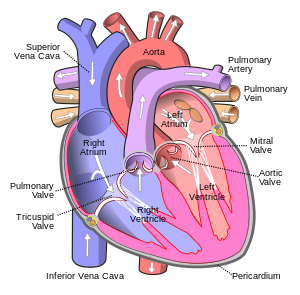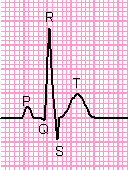A-level Biology/Transport/mammalian heart
Structure
[edit | edit source]
An adult human heart is roughly equivalent to two human fists and weighs around 300g, although this varies from person to person. It basically consists in a bag of cardiac muscles, that pulsates blood across the body as it contracts and relaxes.
Internal
[edit | edit source]The picture to the right shows a vertical section through a human heart, with all labeled blood vessels and sections. The aorta, the large arching vessel is the bodies largest artery, branching upwards towards the brain and the main flow heading toward the rest of your body. The other large vessel leaving the heart is the pulmonary artery, which branches to take blood to both lungs to be re-oxygenated, and the pulmonary veins bring blood back from the lungs to the heart. The vena cava, coming from both the head and the rest of the body are two large veins running vertically on the right side of the heart.
The picture also shows the four chambers of the heart, and the chambers on the left are separated from the right by a wall of muscle known as the septum, forcing blood to leave the heart and be circulated around the lungs and re-oxygenated before returning via the pulmonary vein to the right hand side of the heart. The upper chambers are known as atrium and these receive blood from veins, the right (left on the picture) with the vena cava and the pulmonary vein into the left (on the right) atrium.
The lower chambers are ventricles and blood flows into the ventricles from the atria and is then squeezed into the arteries. The valves between the atria and ventricles are known as atrio-ventricular valves.
You can follow this flow of blood by following the arrows on the diagram.
External
[edit | edit source]The surface of the heart shows the coronary arteries, which branch from the aorta and supply the heart with oxygenated blood it also shows all the other blood vessels that are connected to the heart such as the veins and other capillaries.
Cardiac cycle
[edit | edit source]
The cardiac cycle is basically what happens during one heart-beat, and since it is continuous, a description could begin anywhere. When the heart is filled with blood, the muscles in the atrial walls contracts (known as the atrial systole), and this forces the blood from the atria down through the atrio-ventricular valves into the ventricles. About 0.1 seconds after this, the ventricles contract, known as the ventricular systole
- Ventricles relax, atria contract. Atrial systole This forces the atrio-ventricular valves to open and forces blood into the ventricles.
- Ventricles contract, atria relax. Ventricular systole. The resultant pressure closes the atrio-ventricular valves, and so the blood opens the semi-lunar valves to the pulmonary artery and aorta, and blood flows out there.
- Both relax. Cardiac diastole. The pressure that's now in the pulmonary artery and aorta causes the semilunar valves to close, preventing backflow.
==Heart beat control==nervous control
The heart muscles are myogenic, meaning they contract and relax on their own. They are stimulated by two nodes, the sino-atrial node and the atri-ventricular node. The sino-atrial node is a modified muscle cell collection situated at right auricle that sends out regular electrical impulses to the atrial walls.
- The electrical impulse from the SAN causes the left and right atria to contract simultaneously.
- Collagen tissue prevent the electrical impulses from the atria to the ventricles.
- The atrio-ventricular node picks up the excitation waves as it spreads across the atria, and after a delay of 0.1 seconds it passes it on to conducting fibres, called the Purkyne tissue which runs down the septum between the ventricles where it spreads outwards and upwards through the ventricle walls. This purkyne tissue causes the ventricles to contract simultaneously from the bottom up, squeezing blood upwards and into the arteries.
If the heart loses control, and the excitation wave becomes chaotic, this is known as fibrillation, and it will feed back on itself and re-stimulate areas inappropriately. This can be due to a heart attack or an electric shock. This fibrillation, since the blood is not being pumped properly, is nearly always fatal, but an electric shock can kick the heart back into sequence.
Electrocardiograms
[edit | edit source]
The image on the right is a detection of the voltage within the heart against time and is known as an electrocardiogram (ECG).
- P is the excitation of the atrial walls
- Q, R, S are the ventricle wall excitement
- T is the ventricle walls recovery.